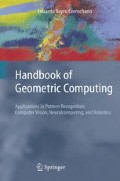Access this chapter
Tax calculation will be finalised at checkout
Purchases are for personal use only
Preview
Unable to display preview. Download preview PDF.
References
Akaike H. (1974) A new look at the statistical model identification. IEEE Trans., AC-19:716–723.
Amari S. (1985) Differential-Geometrical Method in Statistics. Springer, Berlin Heidelberg New York
Amari S. (1998) Natural gradient works efficiently in learning. Neural Computation 10:251–276
Amari S., Kurata K. and Nagaoka H. (1992). Information geometry of Boltzmann machines. IEEE Trans. on Neural Networks 3:260–271
Amari S., Nagaoka H. (2000) Methods of Information Geometry. AMS and Oxford University press, New York
Amari S., Ozeki, T. (2001) Differential and algebraic geometry of multilayer perceptrons. IEICE Trans. Fundamentals E84-A:31–38
Amari S., Park H., Fukumizu K. (2000) Adaptive method of realizing natural gradient learning for multilayer perceptrons. Neural Computation 12:1399–1409
Amari S., Park H., Ozeki, T. (2000) Statistical inference in non-identifiable and singular statistical models. Journal of Korean Statistical Society 30:179–192
Amari S., Park H., Ozeki, T. (2003) Geometrical singularities in the neuromanifold of multilayer perceptrons. Advances in NIPS 14:343–350
Bishop, C. (1995) Neural Networks for Pattern Recognition Oxford University Press, Oxford
Brockett, R.W. (1976) Some geometric questions in the theory of linear systems. IEEE Trans. on Automatic Control 21:449–455
Bottou, L. (1998) Online Algorithms and Stochastic Approximations. In Saad D. ed., Online Learning and Neural Networks. Cambridge University Press, Cambridge, UK
Chen A.M., Lu H., Hecht-Nielsen R. (1993) On the geometry of feedforward neural network error surfaces. Neural Computations 5:910–927
Cover, T.M., Thomas, J.A. (1991) Elements of Information Theory Wiley, New York
Dacunha-Castelle, D., Gassiat, é. (1997) Testing in locally conic models, and application to mixture models. Probability and Statistics 1:285–317
Fukumizu, K. (2003) Likelihood ratio of unidentifiable models and multilayer neural networks. The Annals of Statistics 31:833–851
Fukumizu, K., Amari, S. (2000) Local minima and plateaus in hierarchical structures of multilayer perceptrons. Neural Networks 13:317–327
Hagiwara, K. (2002) On the problem in model selection of neural network regression in overrealizable scenario. Neural Computation 14:1979–2002
Hartigan, J. A. (1985) A failure of likelihood asymptotics for normal mixtures. Proc. Berkeley Conf. in Honor of J. Neyman and J. Kiefer 2:807–810
Hironaka, H. (1964) Resolution of singularities of an algebraic variety over a field of characteristic zero. Annals of Mathematics 79:109–326
Hotelling, H. (1939) Tubes and spheres in n-spaces, and a class of statistical problems. Amer. J. Math. 61:440–460
Kurkova V., Kainen P.C. (1994) Functionally equivalent feedforward neural networks. Neural Computation 6:543–558
Kuriki S., Takemura, A. (2001) Tail probabilities of the maxima of multilinear forms and their applications. The Annals of Statistics 29:328–371
Park H., Amari S., Fukumizu K. (2000) Adaptive natural gradient learning algorithms for various stochastic models. Neural Networks 13:755–764
Rattray M., Saad D., Amari S. (1998) Natural gradient descent for on-line learning. Physical Review Letters 81:5461–5464
Rissanen J. (1978) Modelling by shortest data description, Automatica 14:465–471
Rüger S.M., Ossen A. (1997) The metric of weight space. Neural Processing Letters 5:63–72
Rumelhart D.E., McClelland J.L. (1986) Parallel Distributed Processing: Explorations in the Microstructure of Cognition, vol. 1. MIT Press, Cambridge, MA
Saad, D. and Solla, A. (1995) On-line learning in soft committee machines. Physical Review E 52:4225–4243
Sussmann H.J. (1992) Uniqueness of the weights for minimal feedforward nets with a given input-output map. Neural Networks 5:589–593
Watanabe, S. (2001) Algebraic analysis for non-identifiable learning machines. Neural Computation 13:899–933
Weyl, H. (1939) On the volume of tubes. Amer. J. Math. 61:461–472
Author information
Authors and Affiliations
Rights and permissions
Copyright information
© 2005 Springer-Verlag Berlin Heidelberg
About this chapter
Cite this chapter
Park, H., Ozeki, T., Amari, Si. (2005). Geometric Approach to Multilayer Perceptrons. In: Handbook of Geometric Computing. Springer, Berlin, Heidelberg. https://doi.org/10.1007/3-540-28247-5_3
Download citation
DOI: https://doi.org/10.1007/3-540-28247-5_3
Publisher Name: Springer, Berlin, Heidelberg
Print ISBN: 978-3-540-20595-1
Online ISBN: 978-3-540-28247-1
eBook Packages: Computer ScienceComputer Science (R0)

